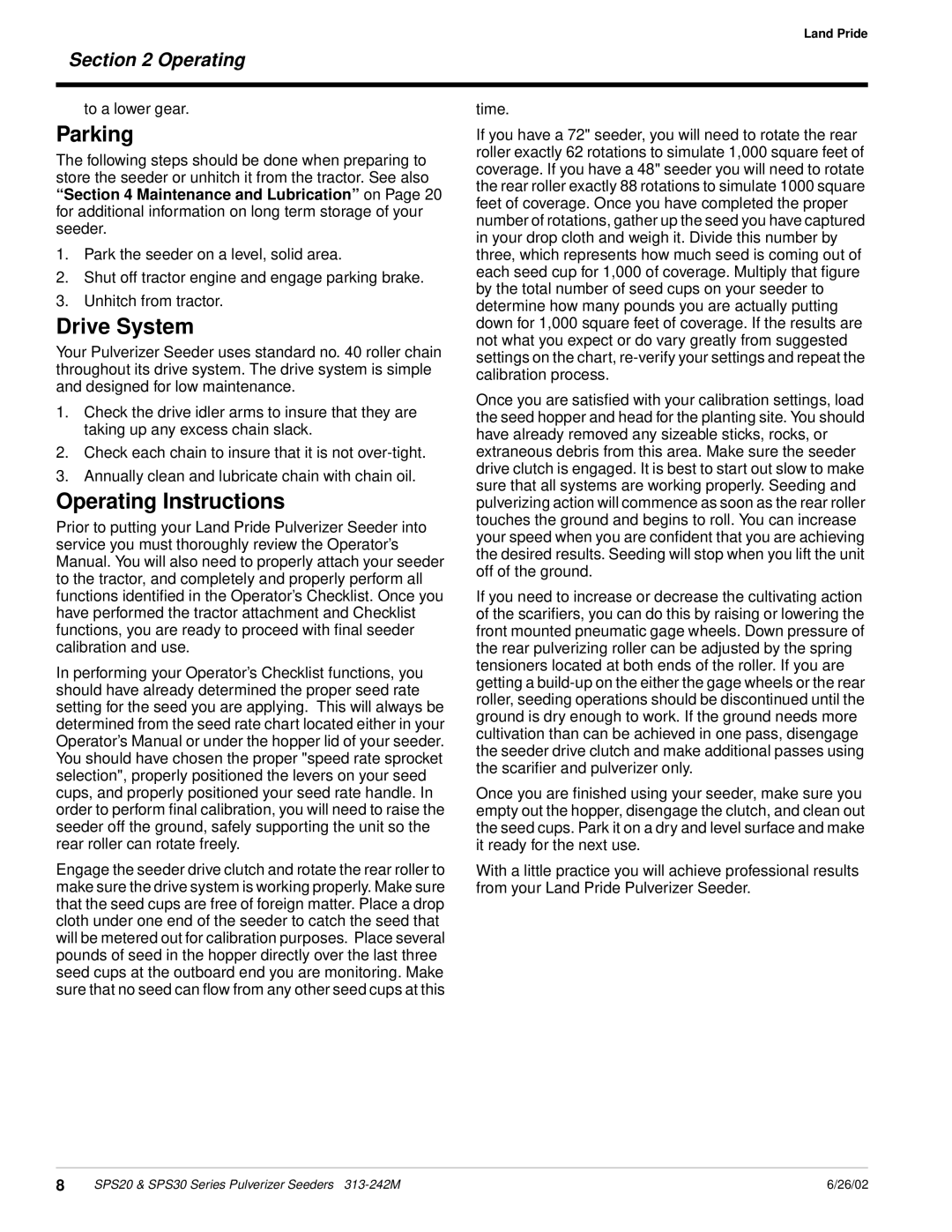
Land Pride
Section 2 Operating
to a lower gear.
Parking
The following steps should be done when preparing to store the seeder or unhitch it from the tractor. See also “Section 4 Maintenance and Lubrication” on Page 20 for additional information on long term storage of your seeder.
1.Park the seeder on a level, solid area.
2.Shut off tractor engine and engage parking brake.
3.Unhitch from tractor.
Drive System
Your Pulverizer Seeder uses standard no. 40 roller chain throughout its drive system. The drive system is simple and designed for low maintenance.
1.Check the drive idler arms to insure that they are taking up any excess chain slack.
2.Check each chain to insure that it is not
3.Annually clean and lubricate chain with chain oil.
Operating Instructions
Prior to putting your Land Pride Pulverizer Seeder into service you must thoroughly review the Operator’s Manual. You will also need to properly attach your seeder to the tractor, and completely and properly perform all functions identified in the Operator’s Checklist. Once you have performed the tractor attachment and Checklist functions, you are ready to proceed with final seeder calibration and use.
In performing your Operator’s Checklist functions, you should have already determined the proper seed rate setting for the seed you are applying. This will always be determined from the seed rate chart located either in your Operator’s Manual or under the hopper lid of your seeder. You should have chosen the proper "speed rate sprocket selection", properly positioned the levers on your seed cups, and properly positioned your seed rate handle. In order to perform final calibration, you will need to raise the seeder off the ground, safely supporting the unit so the rear roller can rotate freely.
Engage the seeder drive clutch and rotate the rear roller to make sure the drive system is working properly. Make sure that the seed cups are free of foreign matter. Place a drop cloth under one end of the seeder to catch the seed that will be metered out for calibration purposes. Place several pounds of seed in the hopper directly over the last three seed cups at the outboard end you are monitoring. Make sure that no seed can flow from any other seed cups at this
time.
If you have a 72" seeder, you will need to rotate the rear roller exactly 62 rotations to simulate 1,000 square feet of coverage. If you have a 48" seeder you will need to rotate the rear roller exactly 88 rotations to simulate 1000 square feet of coverage. Once you have completed the proper number of rotations, gather up the seed you have captured in your drop cloth and weigh it. Divide this number by three, which represents how much seed is coming out of each seed cup for 1,000 of coverage. Multiply that figure by the total number of seed cups on your seeder to determine how many pounds you are actually putting down for 1,000 square feet of coverage. If the results are not what you expect or do vary greatly from suggested settings on the chart,
Once you are satisfied with your calibration settings, load the seed hopper and head for the planting site. You should have already removed any sizeable sticks, rocks, or extraneous debris from this area. Make sure the seeder drive clutch is engaged. It is best to start out slow to make sure that all systems are working properly. Seeding and pulverizing action will commence as soon as the rear roller touches the ground and begins to roll. You can increase your speed when you are confident that you are achieving the desired results. Seeding will stop when you lift the unit off of the ground.
If you need to increase or decrease the cultivating action of the scarifiers, you can do this by raising or lowering the front mounted pneumatic gage wheels. Down pressure of the rear pulverizing roller can be adjusted by the spring tensioners located at both ends of the roller. If you are getting a
Once you are finished using your seeder, make sure you empty out the hopper, disengage the clutch, and clean out the seed cups. Park it on a dry and level surface and make it ready for the next use.
With a little practice you will achieve professional results from your Land Pride Pulverizer Seeder.
8 | SPS20 & SPS30 Series Pulverizer Seeders | 6/26/02 |
